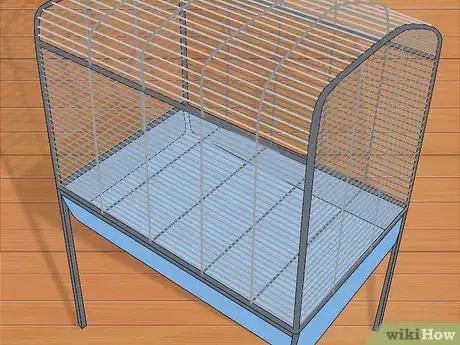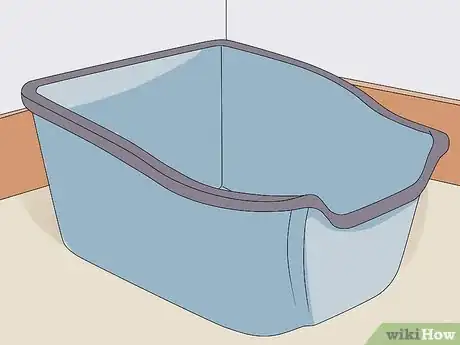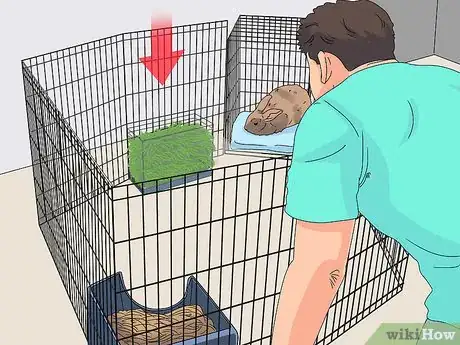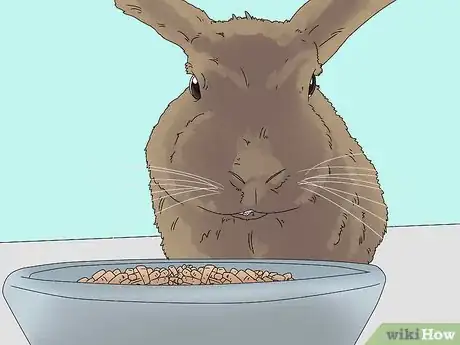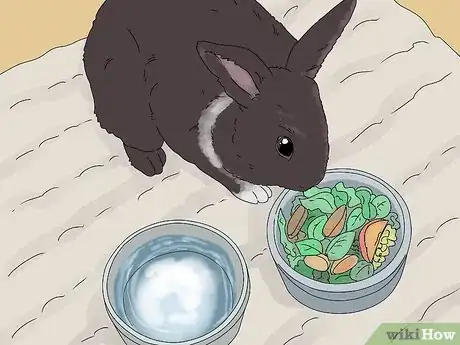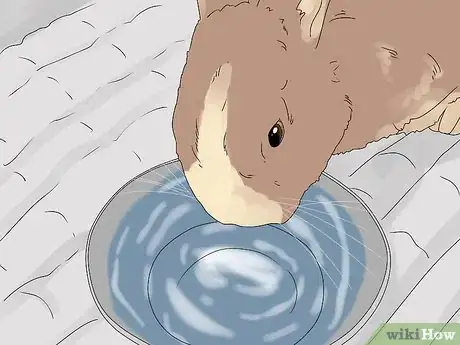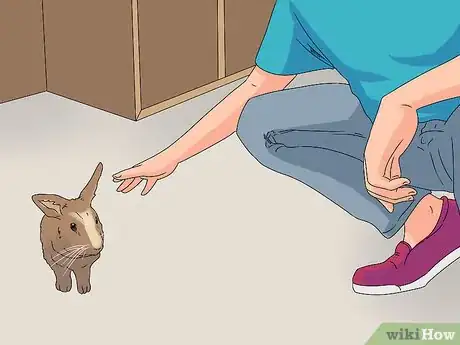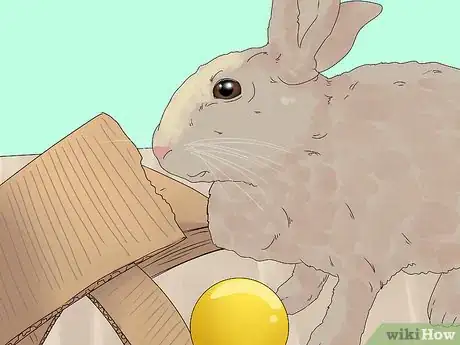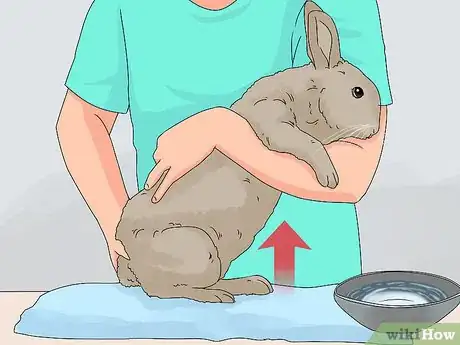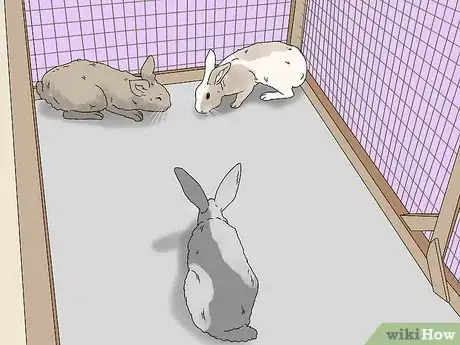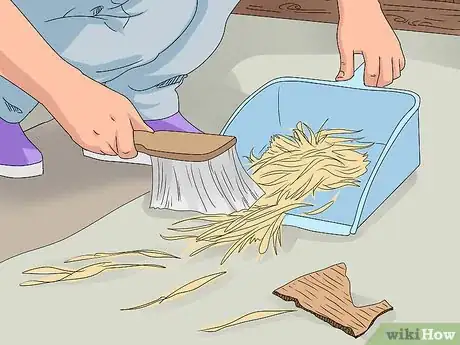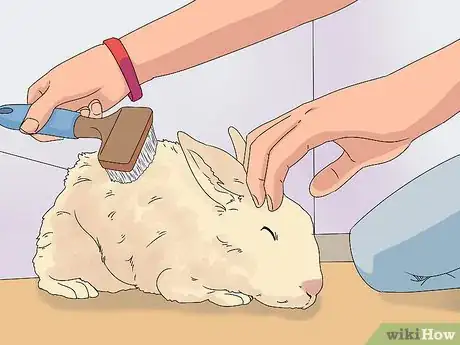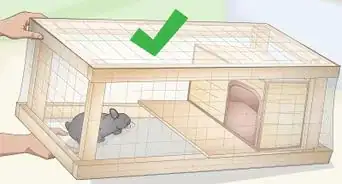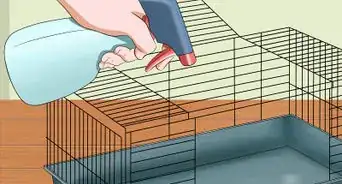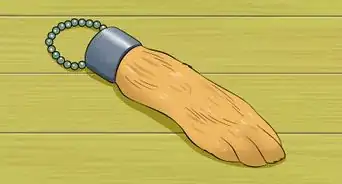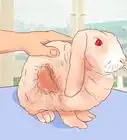This article was co-authored by Pippa Elliott, MRCVS. Dr. Elliott, BVMS, MRCVS is a veterinarian with over 30 years of experience in veterinary surgery and companion animal practice. She graduated from the University of Glasgow in 1987 with a degree in veterinary medicine and surgery. She has worked at the same animal clinic in her hometown for over 20 years.
wikiHow marks an article as reader-approved once it receives enough positive feedback. This article received 61 testimonials and 84% of readers who voted found it helpful, earning it our reader-approved status.
This article has been viewed 1,233,348 times.
If you are thinking about getting a pet, you may want to consider getting a rabbit. Rabbits make excellent pets, as they have wonderful personalities and easily adapt to a domestic lifestyle, even adjusting well to cats or apartments. To stay healthy and happy, rabbits do need some special care, beginning with plenty of hay, pellets, the occasional leafy vegetable, a warm, cozy nest, and time to run and hop to their hearts' content. Rabbits can be kept indoors or outdoors(weather permit as they are sensitive to heat) in a predator proof enclosure. they prefer outdoors because its like there in there natural habitat.
Things You Should Know
- You will need a cage with a solid floor, paper bedding, toys, a litter box, and a hiding hutch for your rabbit.
- Rabbits should have access to an unlimited amount of grass hay and water.
- In addition to the hay, feed your rabbit 2-3 times a day; give them 1/8-1/4 cup of rabbit pellets and mixed veggies.
- Rabbits require a lot of exercise, so let them out for at least 6-8 hours a day if possible.
Steps
Making a Home
-
1Choose a proper housing type. For an average-sized rabbit of 8 pounds or so, you'll need a cage that's at least four feet wide, four feet deep, and three feet tall. The bunny should be able to lay down and stretch out comfortably and still have room for food and water and a litter box.
- Outdoor hutches with wooden floors tend to trap in ammonia and may be unhealthy for your rabbit. A wire floor (preferably pvc coated,14-gauge double-galvanized wire with 1/2" x 1" holes, although 16-gauge galvanized wire with 1/2" x 1") can be acceptable with resting mats, though larger and rex furred breeds may have more trouble with sore hocks than others.
- Get an exercise pen to provide extra space for the rabbit to move around.
- Big bunnies will need larger accommodations. The rabbit needs to be able to move around and lay down freely. Make sure to have a large enough cage so that your rabbit can play!
- Some owners like to do what is called "Free Range Rabbit Housing." This is where you give your rabbit free rein of parts of or the whole house, just as you would with a dog or cat. However, keep in mind that rabbits are heavy chewers and shouldn't be left unsupervised. The area to free roam must be "bunny-proof" and lack wires, baseboards, and carpets for your rabbit to chew on.
-
2Get the right type of cage. Look for a cage with a solid bottom or wire bottom (14-gauge double-galvanized wire with 1/2" x 1" holes, although 16-gauge galvanized wire with 1/2" x 1" only) and sides made out of wire designed for rabbits. Think of this as the “den” for the rabbit to sleep in and a source of food and water. The plan should be that the bunny spends 8-12 hours or so outside of the cage in a room for bunny-safe exploration.[1]Advertisement
-
3Both cage styles come with pros and cons. Solid floors need to be cleaned more frequently to prevent urine scald and sores. Bedding must be rabbit safe and non-toxic. Wire floor can be cleaned less frequently and is required for breeds with wool to keep feces, bedding and urine from matting in the coat(Otherwise, the rabbit should always be shorn). there must always be resting mats in a wire cage to prevent sore hocks. Larger breeds like Flemish giants have more weight and may not be suitable for wire floors. Rex breeds, like the standard rex have thinner fur on the bottoms of their feet and may be more prone to sores if on wire.
- Choose a cage with a solid bottom or a wire floor with rest mats(14-gauge double-galvanized wire with 1/2" x 1" holes, although 16-gauge galvanized wire with 1/2" x 1" only). The bad reputation wire floors have gotten are from wire misuse and neglect, mainly from using the wrong type of wire floor and/or from not using rest surfaces. Do not be deceived, solid floors come with the risk of urine scald and matting in unshorn wool breeds and also can be abused. Each cage type come with its own pros and cons. Pay attention to your beloved pet, clip nails regularly, and keep the area clean.
- Rabbits are territorial animals and pairing should be done cautiously. While there are rabbits who benefit from the company of another (always spay and neuter before bonding to minimize hormonal aggression!), some may never bond with another rabbit, even when fixed. The most successful pairs are fixed male/female pairs. Unfixed rabbits will often breed, or fight (sometimes gruesomely). Bonding should never be doe with an unfixed rabbit.
-
4For solid floors, line the cage with Paper bedding or Aspen wood shavings. There are also some specialty beddings made of recycled wood pulp that work well.[2] Rabbits like to make cozy nests, so fill the bottom of the cage with soft natural material to keep them comfortable.
- Hay, in addition to being great bedding, is the most important part of a rabbits diet, so make sure you choose the right hay for your rabbit. Timothy or grass hays are appropriate for rabbits. avoid alfalfa hay(only if your rabbit is over six months old) as it is too high in calories, protein and calcium for long term feeding for all adult rabbits.[3]
-
5Place the cage in a rabbit-proof area. You'll want to be able to let your bunny out to hop around, so place the cage in a room that you don't mind sharing and that is safe for the bunny. For instance, remove all electrical cords, small objects, and furniture of value from the room and avoid having chemicals or plants that may harm the rabbit in the room.
- Rabbits like to chew cords but you can buy cord protectors from hardware stores to stop your rabbit from chewing them.
- Use a baby gate or exercise pen for dogs to prevent full access to the house to avoid damage to the furnishings and the bunny.
-
6Provide a litter box. Rabbits will naturally use the same spot as a "restroom" over and over, usually one corner of the cage. Line a small litter box (available at pet stores) with newspaper, then fill it with hay, or litter made specifically for rabbits, and place it in the rabbit's preferred corner.
- Consider putting a second litter box in the rabbit's play area.
-
7Create a hiding place in your rabbit's cage. Rabbits are burrowing prey animals, so providing hiding places, like logs or cardboard boxes, is good for their well-being. One or two per rabbit, depending on how much space you have, will give the rabbits plenty of room to huddle.
-
8Add cardboard boxes for the rabbit play in, hide in and chew on.[4] Rabbits adore chewing, and it keeps their teeth healthy. If you don't provide rabbit chews as snacks, it may chew on your furniture or other items you have lying around.[1]
- Make sure your rabbit always has something safe to chew on. This will wear down its teeth and prevent injury.
Providing Food, Snacks and Water
-
1Put out unlimited grass hay. This is the main component of a rabbit's diet and so it should be available at all times. Timothy, oat, and brome hay are good choices. Put it out on a daily basis in a clean area of the rabbit's cage.
- For young growing rabbits (up to 4 months) feed alfalfa hay and pellets to provide extra calories needed for these life stages.[3]
- Dried ready grass hay is available from pet shops and feed stores or you can grow a tray of grass specially for the rabbit.
-
2Give the rabbit a dish of rabbit timothy hay pellets. These contain protein and fiber, essential for growing bunnies. Adult rabbits should get 1/4 cup for every 5 pounds of body weight. [1]
- Rabbits are herbivores and even vegetables can make them gain weight(avoid feeding vegetables too frequently or if rabbit is young as they have sensitive guts) . Pellets are more concentrated energy than hay and should be fed sparingly.
- Remember that your rabbit can't live on pellets alone. It is very important for the rabbit’s digestive tract to have long stem indigestible fiber in the form of Timothy or grass hay to prevent hairballs (trichobezoars) and to keep its digestive system happy and healthy. Chewing on long stem fiber also helps to wear down the rabbit’s continuously growing (hypsodont) teeth and prevent dental problems.
- Baby rabbits can have as many alfalfa pellets as they want until they are 6-7 months of age.
-
3Offer vegetables only as treats. Rabbits are famous for loving carrots, but these should only be given occasionally, as they have high sugar content.[5] Veggies are a treat. Wash the veggies completely and, if possible, feed organic greens.
- Provide leafy greens like spinach as well as collards and turnip greens. In addition, mustard greens, cilantro/parsley, watercress, celery, and dandelion leaves are good vegetables for your rabbit.
- Introduce greens a little at a time to avoid digestive upset. Younger rabbits, 12 weeks an older, you can add in one veggie a week, about a half an ounce at a time to avoid disrupting the cecum.[3]
- Fruit is high in sugar, and should be fed sparingly.
-
4Avoid giving your rabbit unhealthy foods. Some vegetables aren't good for rabbits, including corn, iceberg lettuce, tomatoes, cabbage, beans, peas, potatoes, beets, onions, kale, and rhubarb. Also avoid feeding the rabbit with bamboo, seeds, grains, and any type of meat.
- Human foods such as bread, chocolate, candy, dairy, and anything cooked should not be given to rabbits.[5]
- Do not give your bunny light lettuce (such as iceberg). It may kill them by causing diarrhea and digestive upset of the good bacteria in the gut. Romaine is best, but make sure it's organic if possible, and wash it before offering it to your rabbit.
- You can allow a rabbit to eat grass that has not been sprayed with herbicides or pesticides and let the bunny choose what to eat on the lawn. However, avoid cut grass that has been heated and crushed by the mower. The process of cutting it will hasten the fermentation process and can lead to bunny digestive problems.[6]
-
5Supply plenty of clean water. Fresh water must always be available and changed daily. You can put it in a bowl or in a bottle of the sort used to feed hamsters, but rabbit size, although a bowl of water can be easily spilled. Make sure it never runs out and clean it out frequently to prevent contamination.
- Make sure, if using a water bottle, that it is working properly and is not stuck open or closed.
Giving the Rabbit Exercise and Play Time
-
1Introduce yourself to a new rabbit slowly. When you first get a rabbit, leave it in its cage or hutch so it can get used to its home. Don't approach it straight away and start playing with it, as it hasn't really settled in yet and doesn't really know you and trust you yet.
- Approach a new rabbit slowly and calmly so the rabbit doesn't get scared. Rabbits get scared very easily and can't see very well, so you should speak before approaching.
- Try not to approach the rabbit if it looks like it's busy or laying down and being calm. This can startle the rabbit.
-
2Let the rabbit out for several hours (6 to 8, if you can) per day. Rabbits love to hop and run around, and to stay healthy they need the opportunity to do so for several hours every single day. You can play with your bunny or leave it to enjoy itself on its own (but keeping an eye on it), but don't neglect this important element of rabbit care.
- Make sure your rabbit is either fenced in a pen that is at least 1 foot (0.3 m) in the ground and 3 feet (0.9 m) out of the ground, or on a rabbit harness and leash.[4]
- If you'd like to play with the bunny outside, make sure you're in a fenced-in area, and never leave it unattended.
- Keep cats, dogs, and predatory birds away from the bunny at all times.
-
3Give the bunny plenty of toys. They like to chew up cardboard boxes and old phone books. You can also try playing with your bunny by tossing a small ball or stuffed toy.
- You can use some toys around the house, like loo roll tubes, old towels (that can be nibbled at or scratched).
-
4
-
5Take time to bond. Bonding with your rabbits can be slightly difficult to begin with, as they like being given treats and a little scratch behind the ears occasionally, but much to people's surprise, a lot of the time they enjoy being picked up less. This is because (especially when you first get them) they don't like being taken out of their comfort zone and this can leave them feeling exposed.
- Don't be disheartened if at the beginning they bite and scratch furiously every time you try. It is like this for virtually every new rabbit owner. Remember to be gentle and calm, and don't get angry at yourself or the rabbit. Keep working at it, when you do it successfully, give them a small treat such as apple to let them know they have done a good job.
- When you have bonded with your rabbits, interact with them as much as possible. This helps to build a happy and great relationship which is very rewarding as rabbits are curious and playful animals, and will give out as much love as they get back.
-
6Maintain a schedule for playing. This will give your rabbit something to look forward to every day. Make sure you dedicate time towards this because your rabbit will love having company and will need some exercise.
Keeping More than One Rabbit
-
1Caring for two bunnies isn't much harder than caring for one, so you might want to invest in a second pet.
- Make sure the bunnies are spayed or neutered, especially if you're housing them in the same cage. Rabbits breed very quickly, and have several babies at a time. fixing may reduce hormonal aggression. Introduce your rabbits slowly and supervise them together to ensure they don't injure each other. Not all rabbits can be housed with other rabbits, though many can enjoy the company of others.
- Be sure to get one that is a good fit with the rabbit you already have.[5]
- If you think you want more than one rabbit, get litter-mates at the same time so they are the same age and similar size. Have the bunnies spayed or neutered right away so you don’t have unwanted litters and you prevent some hormonally driven behavior issues.
-
2Introduce new rabbits to others gradually. In an established household, you will need to introduce new arrivals slowly, to prevent fighting. Rabbits can be territorial. A male and female or two females will likely be easier matches than two males unless they are babies.
- Have the rabbits in cages far apart on neutral ground for a few days and watch what they do. If they are thumping and agitated, place the rabbits further apart or in separate rooms for a few more days and then bring them back in eyesight. This would be a good time, when introducing them, to have yummy veggies to distract the rabbits but also increase the positive association of the presence of the other rabbit.
- Gradually decrease the distance between the cages until they are next to each other, but still safe from “attack.” As long as they are peacefully co-existing in cages next to each other, continue this arrangement for at least a week.
- Then, you can place them in exercise pens with a barrier between them and, if all is okay, allow the rabbits to meet without a barrier, under supervision for a short period of time. Place yummy greens in there, two to three piles, to reinforce all is good.[8] When rabbits are laying down together or grooming each other, bunny life is good.
Keeping Your Rabbit Healthy
-
1Clean the cage every week. Make sure the bunny is under supervision while you work. Empty the dirty hay or shavings from the cage, wash it with hot, soapy water, rinse it thoroughly, and let it dry. Fill it with clean hay or shavings in solid floors, clean trays in wire floors.
- The litter box needs to be changed out every day and thoroughly disinfected every week or so with a 10% white vinegar solution. Rinse well and allow to dry. If the litter box is plastic or metal, you can also place it in the dishwasher.
- Have more than one litter box so that you can switch a clean one while the other box is dirty or in the process of being cleaned.
- Rabbit urine is very alkaline and crystals can build up on the surface of the litter box and require the use of a descaling solution.
-
2Keep the temperature right for your rabbit. Optimum temperature for rabbits is 61 to 72F. If your rabbit is outside, provide plenty of shade and, if it gets really hot, bring them indoors to air conditioning or place frozen water bottles in the hutch to help the rabbit keep cool. Rabbits can die of heat stroke.
- The rabbit’s ears are really the main temperature control part of their bodies. Panting with bright red ears may be a sign of over-heating.
- If they were in the wild, the rabbit would go underground where it is cool to get out of the heat.
-
3Brush the rabbit. Wool breeds (like English, Giant, French, Satin Angoras) need more grooming than others if not shorn. They need to be groomed daily, especially if the wool fibers are thin. Careful brushing of any mats and blowing out the coat is recommended (never blow with hot air). Remember that the rabbit's skin is thin and pulling on the mat can damage it. If a mat is seriously stubborn, clip it away. Also note that these breeds and crosses with wool tend to also have wool on the feet that can get matted. Mats on the feet can part the protective hairs of the foot and lead to sore hocks, so pay special attention to a wool breed's feet when grooming.
- Bathing should never be done, but you can use a soft-bristled brush to groom. If you have two rabbits, you may notice them grooming each other.
- Rabbits do not need to be bathed unless they get very dirty and are not able to groom themselves properly. Only if needed, bathe the dirty bottom of the rabbit only. Never bathe whole rabbit as the sudden change in temperature from wet fur can bring rabbits into shock.
-
4Take the rabbit to the veterinarian at least once a year. Rabbits need annual checkups to make sure they're healthy. Many veterinarians who treat cats and dogs do not have expertise in treating bunnies, so you may need to find a vet who treats "exotic" animals.
- Depending on where you live, your veterinarian may recommend vaccination for certain diseases like Myxomatosis if you live in the United Kingdom. In the United States, Myxomatosis vaccination is not currently recommended.[3]
- Your veterinarian will do an examination and discuss their findings and make recommendations based on your rabbit’s current condition. Managing healthy dentition in rabbits may require anesthesia to fully examine the teeth and address any sharp points discovered on the back teeth (premolars and molars).[5]
-
5Learn how to read rabbit body language. Knowing how your rabbit is feeling is extremely important if you want your bunny to be happy and healthy.
- If a rabbit's ears are flat on its back, its eyes are bulging and its body is tense and hunched up, it is scared. If a rabbit is really terrified, it may be trembling and breathing heavily.
- If a rabbit is very relaxed chilled out, it will be laying stretched out with its front paws in front of it, or it may have all its paws tucked beneath its body. It may also be laying on its side. Its ears may be flat on its back.
- Sometimes, when a rabbit is extremely happy and excited, it will jump into the air and flick its body. This is called a binky. Many rabbits will run around very quickly before binkying. Sometimes, if a rabbit is feeling lazy, it won't do a proper binky but will remain on the ground and do a sort of shuddery-flick.
Expert Q&A
Did you know you can get expert answers for this article?
Unlock expert answers by supporting wikiHow
-
QuestionWhat should you do if you go on vacation for a long time?
 Pippa Elliott, MRCVSDr. Elliott, BVMS, MRCVS is a veterinarian with over 30 years of experience in veterinary surgery and companion animal practice. She graduated from the University of Glasgow in 1987 with a degree in veterinary medicine and surgery. She has worked at the same animal clinic in her hometown for over 20 years.
Pippa Elliott, MRCVSDr. Elliott, BVMS, MRCVS is a veterinarian with over 30 years of experience in veterinary surgery and companion animal practice. She graduated from the University of Glasgow in 1987 with a degree in veterinary medicine and surgery. She has worked at the same animal clinic in her hometown for over 20 years.
Veterinarian You need to ensure that your rabbit will be taken care of while you are away. You can look into a boarding facility where your rabbit will be fed, groomed, and have regular interaction with people. If a facility is not an option, then find a pet sitter to check on your rabbit at least once a day to feed, water, and play with your rabbit. Consider asking a trustworthy friend or neighbor.
You need to ensure that your rabbit will be taken care of while you are away. You can look into a boarding facility where your rabbit will be fed, groomed, and have regular interaction with people. If a facility is not an option, then find a pet sitter to check on your rabbit at least once a day to feed, water, and play with your rabbit. Consider asking a trustworthy friend or neighbor. -
QuestionThere is something white on my rabbit's back, and I do not know what it is. What should I do?
 Pippa Elliott, MRCVSDr. Elliott, BVMS, MRCVS is a veterinarian with over 30 years of experience in veterinary surgery and companion animal practice. She graduated from the University of Glasgow in 1987 with a degree in veterinary medicine and surgery. She has worked at the same animal clinic in her hometown for over 20 years.
Pippa Elliott, MRCVSDr. Elliott, BVMS, MRCVS is a veterinarian with over 30 years of experience in veterinary surgery and companion animal practice. She graduated from the University of Glasgow in 1987 with a degree in veterinary medicine and surgery. She has worked at the same animal clinic in her hometown for over 20 years.
Veterinarian
-
QuestionDoes my rabbit need shots in the UK?
 Pippa Elliott, MRCVSDr. Elliott, BVMS, MRCVS is a veterinarian with over 30 years of experience in veterinary surgery and companion animal practice. She graduated from the University of Glasgow in 1987 with a degree in veterinary medicine and surgery. She has worked at the same animal clinic in her hometown for over 20 years.
Pippa Elliott, MRCVSDr. Elliott, BVMS, MRCVS is a veterinarian with over 30 years of experience in veterinary surgery and companion animal practice. She graduated from the University of Glasgow in 1987 with a degree in veterinary medicine and surgery. She has worked at the same animal clinic in her hometown for over 20 years.
Veterinarian
Warnings
- Do not ever give full baths to your rabbits; they could get hypothermia or go into shock. Rabbits tend to groom themselves.⧼thumbs_response⧽
- Do not try to pair a rabbit with a guinea pig. They have different dietary and medical needs (e.g. rabbits can synthesize their own Vitamin C, while guinea pigs can’t) and rabbits may accidentally injure guinea pigs.⧼thumbs_response⧽
- Try your very best not to drop your rabbit. Although they are resilient, dropping them on the wrong place or from a great height can seriously injure/kill them.⧼thumbs_response⧽
- There are many different personality types of rabbits; some are jumpy, some are lazy, and some are in-between. Don't force your rabbit to play if it doesn't seem to want to.⧼thumbs_response⧽
- Make sure your rabbit's outdoor play area is secure, as rabbits can squeeze through very small spaces and are very difficult to catch if they run and hide. Also, make sure predators, such as dogs and cats, can't get in. Make sure they cannot dig out.⧼thumbs_response⧽
- Do not put flea medications on your rabbit. Consult a veterinarian on what to do if your rabbit has fleas.⧼thumbs_response⧽
- Rabbits can bite or scratch.⧼thumbs_response⧽
- Be cautious of predators. They can be very determined when they think a meal is at stake, and sometimes basic chicken wire isn't a good enough wall between the rabbits and predators. Consider putting an extra covering over the hutch at night to prevent spooking.⧼thumbs_response⧽
Things You'll Need
- Large cage with a solid bottom
- Only use wire if it is 14-gauge double-galvanized wire with 1/2" x 1" holes, although 16-gauge galvanized wire with 1/2" x 1" and accompanied with rest mats, PVC coated is even better.
- Wood shavings
- Newspaper
- Timothy and/or alfalfa hay
- Fresh leafy vegetables
- Food pellets
- Rabbit chews (toys)
- Carrying cage
- Litter box
- Water bottle
- Rabbit brush or a small bristled cat brush
References
- ↑ 1.01.11.2http://www.aspca.org/pet-care/small-pet-care/general-rabbit-care
- ↑ http://www.healthy-pet.com/carefresh
- ↑ 3.03.13.23.33.4http://rabbit.org/faq-diet/
- ↑ 4.04.1http://www.veterinarypartner.com/Content.plx?P=A&S=0&C=0&A=3015
- ↑ 5.05.15.25.35.4http://www.petfinder.com/pet-care/rabbit-care/care-domestic-rabbits/
- ↑ http://www.therabbithouse.com/blog/2009/05/22/rabbits-eat-grass/
- ↑ 7.07.1Sharon L. Crowell-Davis, Behavior Problems in Pet Rabbits, Journal of Exotic Pet Medicine, Volume 16, Issue 1, January 2007, Pages 38-44, ISSN 1557-5063
- ↑ http://www.rabbitmatters.com/introducing-rabbits.html
About This Article
To care for a rabbit, get a large cage with solid that was designed for a holding a rabbit or other small animal. Line the cage with hay or soft wood shavings, and provide a litter box inside of the cage. Then, make sure the rabbit has unlimited access to grass hay, and feed them regularly with timothy hay pellets. Offer vegetables like spinach, celery, and the occasional sugary treat, like carrots and fruit. Make sure the rabbit has clean water in a bottle at all times. Scroll down for tips on playing with your rabbit and keeping it healthy!

